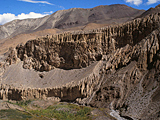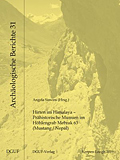With contributions of Kurt W. Alt, Angela von den Driesch (†), Christian-Herbert Fischer, Birgit Großkopf, Wolfgang Gruhle (†), Gisela Grupe, Arie J. Kalis, Karl-Heinz Knörzer (†), Jutta Meurers-Balke, Susan Möller-Wiering, Nicole Nicklisch, Burghart Schmidt, Angela Simons, Werner Vach & Tanja Zerl.
Archäologische Berichte 31
The prehistoric burial cave Mebrak 63 with mummified bodies is situated in a high mountain valley of the Himalayas in the North of Nepal. The investigation of the findings and remains, which are so far unique due to their preservation, provides insight into the way of life and the widespread exchange and trade links of the prehistoric people in a valley in the high Himalayas.
 Felsriegel von Mebrak mit Höhlensystemen und Terrassensiedlung.After several preliminary reports, this publication presents the complete results of the complex archaeological investigation which started in 1995 with the excavation. Co-operation between archaeology and anthropology, textile archaeology, archaeobotany and dendroarchaeology made it possible to come close to the people who were entombed in the collective burial cave in the last millennium before the Christian era.
Felsriegel von Mebrak mit Höhlensystemen und Terrassensiedlung.After several preliminary reports, this publication presents the complete results of the complex archaeological investigation which started in 1995 with the excavation. Co-operation between archaeology and anthropology, textile archaeology, archaeobotany and dendroarchaeology made it possible to come close to the people who were entombed in the collective burial cave in the last millennium before the Christian era.
 Mebrak: aufsteigende Ausgräberin zwischen dem 3. und 4. Stock des Höhlensystems, ca. 14 m über dem Fuß der Felswand..The burial cave Mebrak 63 is located on the seventh floor of a cave system in Dzong valley. The cave chamber which was hewn into the rock and used as a collective grave, lies about 30 metres above the foot of the rock face. Today, it can only be reached by climbing the rock with special climbing gear. For nearly five centuries, i. e. from about 500 BC to the Christian era, the deceased persons were repeatedly entombed in this burial cave, lying on patterned bamboo mats in wooden bed-shaped coffins, decorated by carved ornaments and painting. Due to the arid climate in the rain shadow of the Himalayan main range, organic material is perfectly preserved; hence, the buried people were mummified owing to the dryness of the environment. The dead were laid down in a crouched position, their hands and feet being tied with bamboo or textile strips. In addition, they were given clothes made of cotton, wool and fur as well as jewellery, tools and food for their life after death.
Mebrak: aufsteigende Ausgräberin zwischen dem 3. und 4. Stock des Höhlensystems, ca. 14 m über dem Fuß der Felswand..The burial cave Mebrak 63 is located on the seventh floor of a cave system in Dzong valley. The cave chamber which was hewn into the rock and used as a collective grave, lies about 30 metres above the foot of the rock face. Today, it can only be reached by climbing the rock with special climbing gear. For nearly five centuries, i. e. from about 500 BC to the Christian era, the deceased persons were repeatedly entombed in this burial cave, lying on patterned bamboo mats in wooden bed-shaped coffins, decorated by carved ornaments and painting. Due to the arid climate in the rain shadow of the Himalayan main range, organic material is perfectly preserved; hence, the buried people were mummified owing to the dryness of the environment. The dead were laid down in a crouched position, their hands and feet being tied with bamboo or textile strips. In addition, they were given clothes made of cotton, wool and fur as well as jewellery, tools and food for their life after death. Östlicher Bettsarg 634 mit den beiden Individuen I.21-22.During the approximately 500 years of occupancy, about 30 people were entombed in the burial cave, men, women and children; so roughly every 15 to 20 years, one deceased person was entombed in the community burial chamber. This frequency is also confirmed by the dendrochronologically determined felling dates of the trees from which the coffin elements were made. A burial sequence could be established by means of radiocarbon and dendrochronological dates as well as stratigraphic features.
Östlicher Bettsarg 634 mit den beiden Individuen I.21-22.During the approximately 500 years of occupancy, about 30 people were entombed in the burial cave, men, women and children; so roughly every 15 to 20 years, one deceased person was entombed in the community burial chamber. This frequency is also confirmed by the dendrochronologically determined felling dates of the trees from which the coffin elements were made. A burial sequence could be established by means of radiocarbon and dendrochronological dates as well as stratigraphic features.
 Kalebasse mit Brandverzierung, Behälter für Hirsebier.There is no doubt that livestock husbandry played a central role for the people in the community. The pastoralists were given their herd animals as companions on their journey to the afterlife (these were mainly goats) and, in addition, horses. The archaeo-botanical analysis shows that food offerings, aside from meat, were almost exclusively collections of wild plants; in some bamboo vessels the ingredients for the preparation of millet beer were found. The "imported plants" such as rice and peas which were also deposited in the grave prove that the pastoralists living in the Dzong valley were in contact with population groups who cultivated fields.
Kalebasse mit Brandverzierung, Behälter für Hirsebier.There is no doubt that livestock husbandry played a central role for the people in the community. The pastoralists were given their herd animals as companions on their journey to the afterlife (these were mainly goats) and, in addition, horses. The archaeo-botanical analysis shows that food offerings, aside from meat, were almost exclusively collections of wild plants; in some bamboo vessels the ingredients for the preparation of millet beer were found. The "imported plants" such as rice and peas which were also deposited in the grave prove that the pastoralists living in the Dzong valley were in contact with population groups who cultivated fields.
 Bettsarg 634: Kopfseite mit Luke und durchgestecktem Langbogen.The clothing given to the deceased also corresponds to their life as pastoralists. Especially the fur clothes, with caftan, trousers and boots, fit into the scheme of the nomadic horsemen in the steppes of Central Asia. Also for the wooden bowls and vessels, there are parallels in Central Asia. Raw materials, such as bamboo for the woven mats and baskets, cotton for the textiles as well as the glass, carnelian and pearls, partly originate from lower regions in Southern Asia and even from far-off places.
Bettsarg 634: Kopfseite mit Luke und durchgestecktem Langbogen.The clothing given to the deceased also corresponds to their life as pastoralists. Especially the fur clothes, with caftan, trousers and boots, fit into the scheme of the nomadic horsemen in the steppes of Central Asia. Also for the wooden bowls and vessels, there are parallels in Central Asia. Raw materials, such as bamboo for the woven mats and baskets, cotton for the textiles as well as the glass, carnelian and pearls, partly originate from lower regions in Southern Asia and even from far-off places.
The investigation of the mummies and the grave goods thus provide an insight not only into daily life but also into the widespread bartering and trading network of the prehistoric pastoralists in the Himalayas.
The editor
Dr. Angela Simons – Studies of prehistory and social anthropology at the University of Cologne, prior to that degree in chemistry at the Technical University of Aachen. From 1992 to 1996 director of the Nepal project at the Institute for Prehistory at the University of Cologne as part of the Nepal-German Project on High Mountain Archaeology: investigations in cave systems in the Himalayas, 1995 excavation of Mebrak 63, the prehistoric burial cave with mummified bodies. Then, until 2018, managing projects for the Archaeological Heritage Conservation in the Netherlands.
The book
Kerpen-Loogh 2019. 481 pages (incl. 213 figs. and 45 tables). Verlag Deutsche Gesellschaft für Ur- und Frühgeschichte (DGUF). Free open access publication: ISBN 978-3-948465-12-4. DOI: https://doi.org/10.11588/propylaeum.596, urn:nbn:de:bsz:16-propylaeum-ebook-596-1
Printed edition: ISBN 978-3-945663-18-9. Softcover. 89,00 Euro, resp. 49,00 Euro as reduced price for members of DGUF. All prices with postage and packing additionally.
CC BY 4.0
Book orders to
DGUF-Verlag
Dr. Werner Schön
An der Lay 4
D-54 573 Kerpen-Loogh
Germany
Phone: +49 / 6593 / 9896-42
Fax: +49 / 6593 / 9896-43

